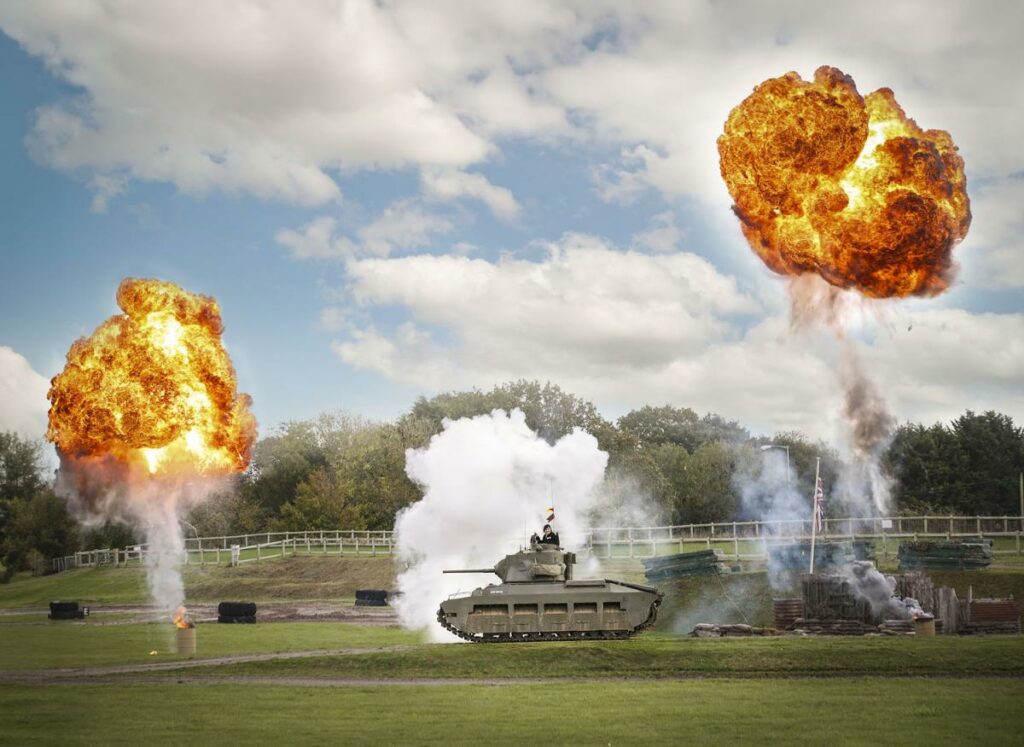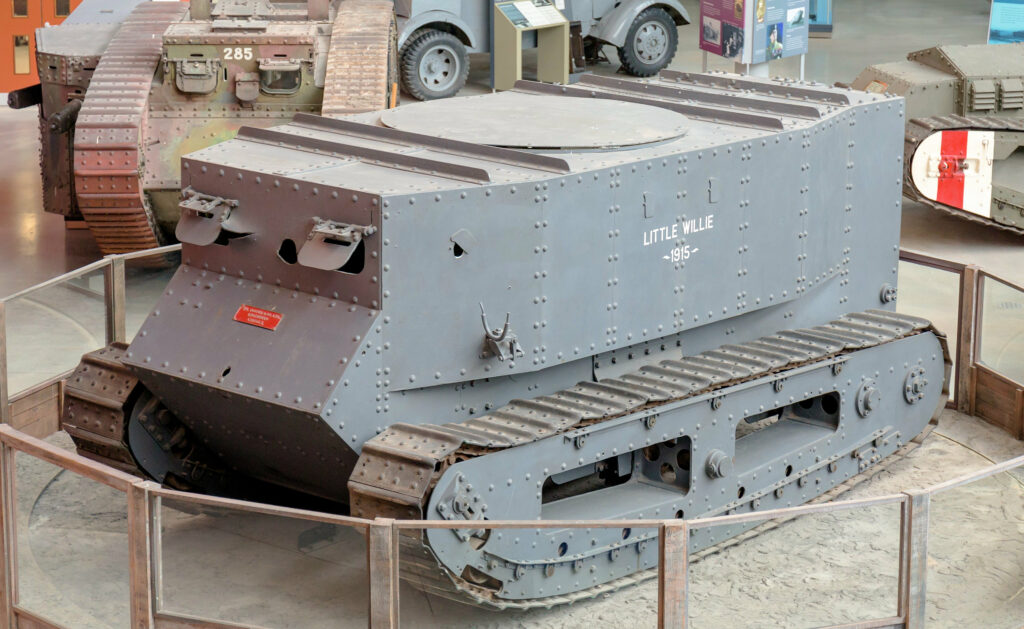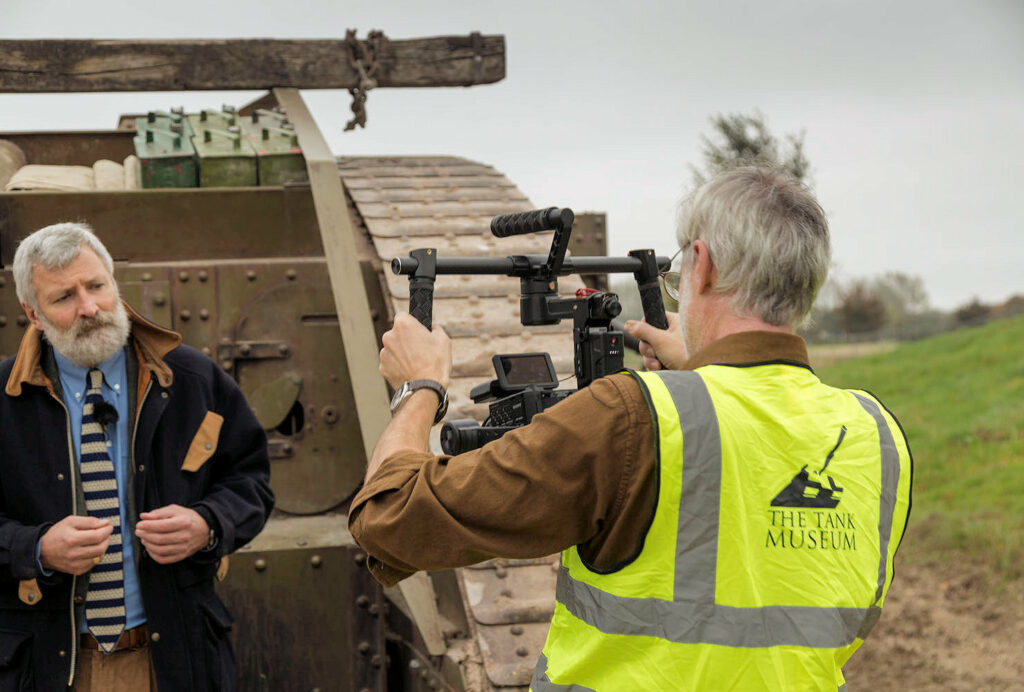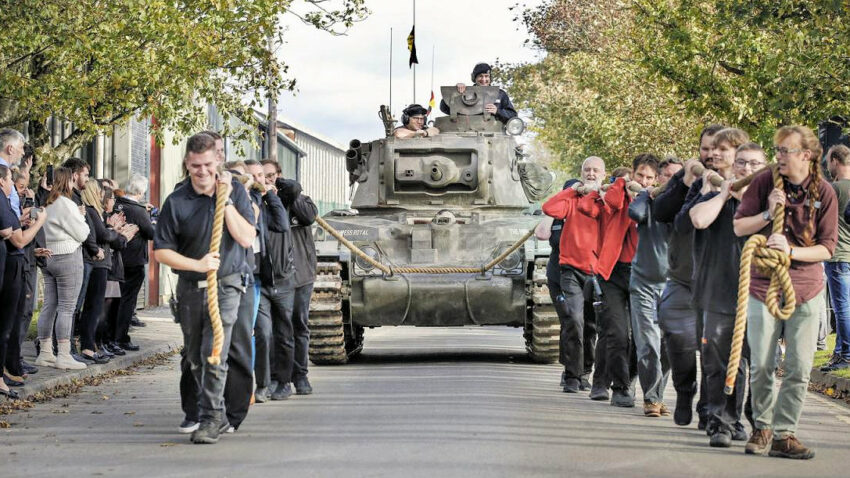The Tank Museum at Bovington is hosting a special Armistice event to honour the part that tanks played in winning the First World War.
It comes as the world famous Dorset museum has changed its director for the first time in 17 years and is getting ready to welcome the chief executive of a steam railway to drive it forward in the future.

Richard Smith filming for the museum’s YouTube channel at TankFest 2023
Pulled away in a Matilda tank
Outgoing director Richard Smith was given a fitting send off on his final day, pulled away from the museum in the commander’s seat of a World War Two Matilda tank.
The tradition has its origins in British armoured regiments when outgoing commanding officers would be taken through the garrison gates in a tank drawn by senior officers.
During Richard’s 17 years in charge at Bovington, the museum saw a total redevelopment which doubled annual visitors to almost a quarter of a million, and saw annual turnover increase from £1.6 million to £6 million.
Richard, who often appears on the Tank Museum’s hugely popular YouTube channel to share his passion for history, is leaving to take the role of executive director at Gresham College in the City of London, which has provided free public lectures for more than 400 years.

Richard Smith in the commander’s seat of a Matilda tank, getting a send off with a bang
Upset that his pet parrot was banned
Richard Smith said:
“I have enjoyed many happy years at the Tank Museum, taking on a variety of challenges from multi-million-pound development projects to responding to a complaint from a visitor who was upset he could not bring his pet parrot into the museum!
“Back in 2006, I was working and living in Hong Kong with an Australian wife who I had met in America and my mother, back in England, realised that access to her new granddaughter would depend on me having a job in the UK.
“After scouring the newspaper adverts for some weeks, she sent me an email saying ‘I think I’ve found the job for you’ – director of the Tank Museum!
“It wasn’t quite as random a suggestion as it may sound, I had done a history degree for which my dissertation had been about First World War tanks with my research done at Bovington, and British 20th Century military history has always been my greatest interest.”

Richard Smith welcomed the late Queen Elizabeth II to the Tank Museum when it reopened in 2009 after redevelopment
“This is the best job in the world”
Richard Smith added:
“Although I pointed out to my mother that I had never worked in a museum and it might be something of a long shot, the museum trustees agreed with her, and I have worked at the Tank Museum ever since.
“I have always said that this is the best job in the world, and whilst it still is, the time is right for me to find a new challenge.
“It is an enormous privilege to take a subject about which I am personally passionate and to have the chance to bring it alive to hundreds of thousands of people every year. Even after so long, my job leaves me with a lingering feeling of getting away with something.
“I would like to thank all the trustees and staff for their hard work and support, and I am confident that the Tank Museum will remain in good hands.”

Richard Smith (left) hands over the keys of the Tank Museum to new director Chris Price
New director works for steam railway
Museum spokesperson Nik Wyness said:
“As the longest serving director in the museum’s history, Richard oversaw the transformation of the Tank Museum from a Dorset curiosity to one of the leading military museums in the world.
“The staff are all extremely grateful for Richard’s leadership and support over the years. We wish him well in his next challenge and look forward to welcoming his successor in the new year.”
Richard hands over to Chris Price, currently chief executive of North Yorkshire Moors Railway, one of 120 applicants for the job, who will assume the new role in January 2024.
Chris steered the railway through many changes and milestones, through the uncertainty of Covid-19 to welcoming King Charles III on his first public appointment as monarch.
He has built up the visitor base to around 300,000 people per year, and was key to securing a £4.6 million grant from the National Lottery Heritage Fund for the heritage steam railway charity in Yorkshire.

A special screening of a new war film will be shown at Bovington featuring music from Swedish band Sabaton
Armistice special screening of war film
Before the new chief executive arrives in Bovington, the Tank Museum has a special event on Monday 13th November 2023 with a special screening of the film The War To End All Wars to mark the Armistice.
The film was created by the Swedish metal band Sabaton to tell stories from the First World War on the 105th anniversary of the Armistice and features music from their latest album, The War to End All Wars, that was inspired by the conflict.
Sabaton bass guitarist Pär Sundström will take part in an exclusive meet and greet session at a special screening of the film at the Tank Museum, answering questions about it afterwards.
Sabaton fans chose the Tank Museum to screen the film as part of the History Rocks initiative to bring together a new audience of history enthusiasts to museums worldwide.

Little Willie, dating back to 1915, is the oldest tank in the world
How Little Willie got its name
The museum has the largest collection of First World War tanks in the world including Little Willie, the first completed tank prototype in history and the world’s oldest surviving tank dating back to 1915.
Its unusual name was said to be a derogatory name for the German Crown Prince, Kaiser Wilhelm, and it was meant to be the invention which would win the war for the Allies – which was only partially true.
By the time Little Willie was finished, its inventors had already come up with an improved design with tracks running all the way around the vehicle, which would be able to cross trenches.
Following the modest success of the Mark I tanks on the Somme in 1916, British commander in chief Sir Douglas Haig ordered 1,000 more tanks for 1917, a surprising act of faith in a new weapon.

The Mark IV tank helped to breach the German trenches and speed up the end of the war
Tanks helped to win the war
The Mark IV entered service in May 1917, the first tank to be mass produced and really could be said to have helped win the war.
Its groundbreaking design as an armed and armoured vehicle allowed them to create gaps in the barbed wire, knock out machine gun posts and bunkers, cross trenches, and protect infantry long enough for the trench networks to be captured.
The Mark IV was the mainstay of the Tank Corps at the Battle of Cambrai in November 1917 and fought through to the end of the war, winning the first ‘Tank versus Tank’ battle in April 1918 by knocking out the German A7V tank Nixe.
Their main drawback was their weight and speed – no faster than walking pace – but the French allies designed a two man tank, the Renault FT, which could speed along at 7 mph and helped chase the German armies back to Berlin during 1918.

Curator of the Tank Museum, David Willey, believes that tanks were a major part in ending World War I
“Final nail in coffin for the Germans”
Tank Museum curator David Willey said:
“It’s part of that final nail in the coffin for the Germans, they are being blockaded by the British and running out of fuel and food.
“When you started to see the German memoirs in the 1920s asking the question ‘why did we lose the war’, the tank was always mentioned.”
Watch the explanation of how the Mark IV helped win the war
Further information
- Book tickets for Tank Museum events via its website





